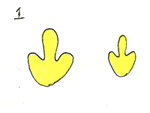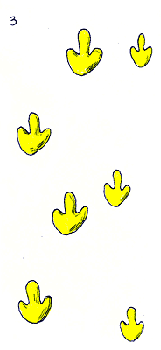To see how science works, imagine you discovered two sets of dinosaur tracks. Also pretend that you are the first person ever to see these dinosaur tracks. You start with a simple question – which is the bigger dinosaur? You see that one type of footprint is bigger than the other (1). Your first hypothesis: “The dinosaur with the bigger footprint is bigger.”

But then you see that the footprints are farther apart for the dinosaur with little footprints (2). Your second hypothesis is, “Maybe the dinosaur with the small feet is taller because its footprints are farther apart.”

 And then you notice that the big footprints are deeper than the little ones (3), and you think, “Maybe the big-footed dinosaur is bigger, because heavier animals should leave deeper footprints in the mud.”
And then you notice that the big footprints are deeper than the little ones (3), and you think, “Maybe the big-footed dinosaur is bigger, because heavier animals should leave deeper footprints in the mud.”
 You follow the tracks a bit farther, and find that the footprints of the big-footed dinosaur get farther apart (4) – and are even deeper, and you realize that he might be running after the small-footed dinosaur – which was running all along.
You follow the tracks a bit farther, and find that the footprints of the big-footed dinosaur get farther apart (4) – and are even deeper, and you realize that he might be running after the small-footed dinosaur – which was running all along.
But do you know that for sure? How could you test whether your conclusion is right about which dinosaur is heavier?
Some answers given to me by third-graders in Cedar Falls, Iowa:
“You find dinosaur skeletons and see if the foot matches the footprints.”
“You see how the footprints change when the dinosaur is running (to do this, you have to run yourself – do just your toes touch the ground? Or your heels? Do your feet hit the ground harder?)”
But then, someone said, “The footprints are so old – maybe the two sets of tracks weren’t even made the same day!”
Fortunately, if you could match the footprints to dinosaur footbones, it might not matter whether the tracks were made on different days. In real life, you might also look at what dinosaur footprint experts have said about the two types of footprints you observed.

thank you for sharing
This article is very interesting and exciting
thanks you share article very good and interesting
you share article very good and interesting 